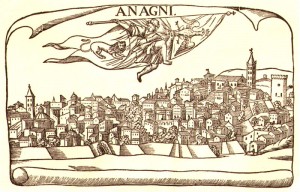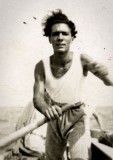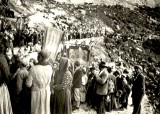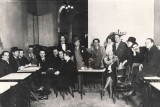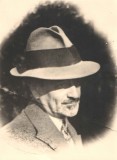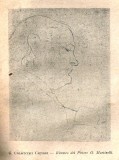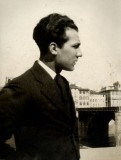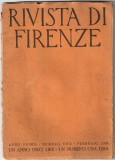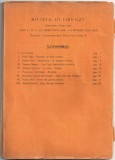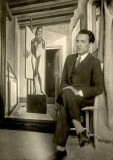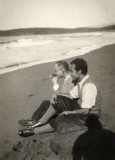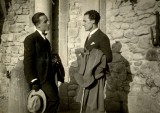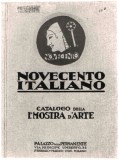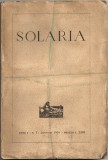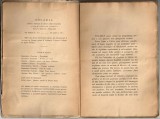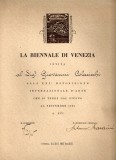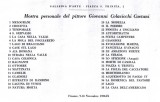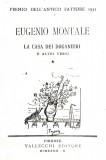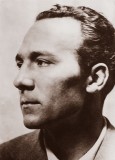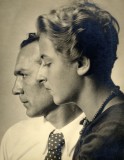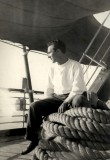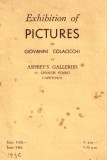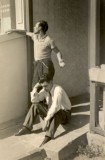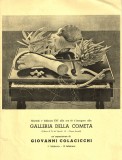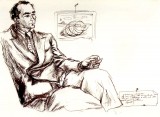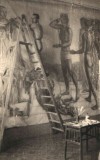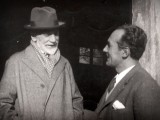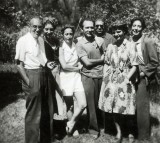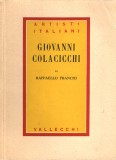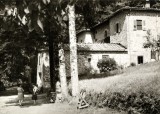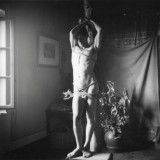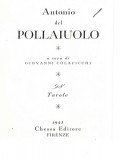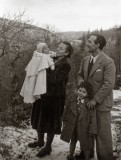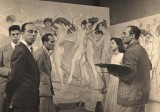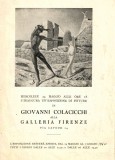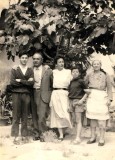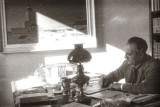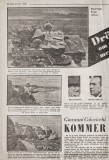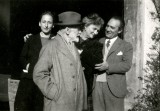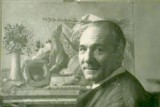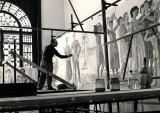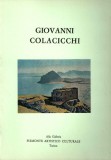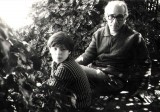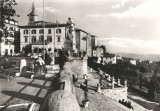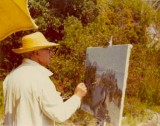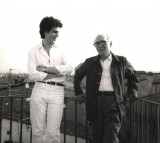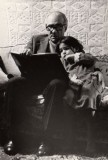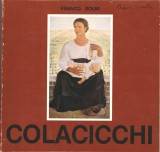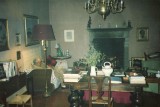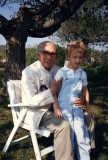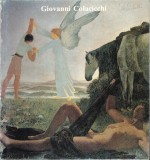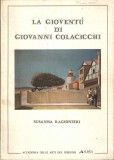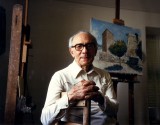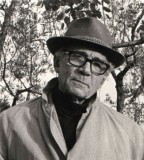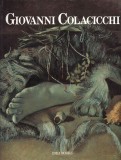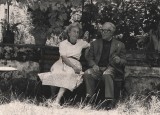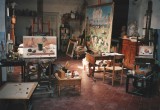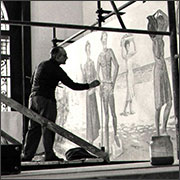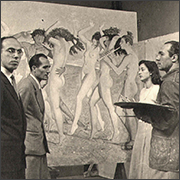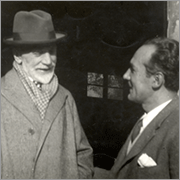1900
On 19 January Giovanni is born at Anagni in Lazio. His father is Roberto Colacicchi and his mother Pia Vannutelli.
1914
Attends school (Liceo) in Rome.
1916
Arrives in Florence to finish school and lives there for the rest of his life. Works as an assistant at the Scolopi school overseeing the pupils while they do their homework.
1917/18
After the disastrous Italian defeat at Caporetto enrolls in the bersaglieri division and departs for the front in the “Arditi” squadron, but the end of hostilities are declared while they are still in the train.
Meets the painter Cepparelli and carries out his first exercises in drawing and painting in his studio.
1919
Graduates from high school and goes to paint in San Gimignano where he watches the painter De Grada at work.
Returns to Anagni, where he writes poetry and paints.
1920
Enrolls in the faculty of Letters and Philosophy at the university of Florence. Together with sculptor Giuseppe Graziosi, painter Francesco Franchetti, and the writers Alessandro Bonsanti, Eugenio Montale, Alberto Carocci, and Elio Vittorini frequents the Giubbe Rosse cafè, an important meeting place for Florentine intellectuals.
Begins to work in the studio of Franchetti who he always considered his only real maestro.
1921
While spending some time in Rome he gets to know his contemporary Onofrio Martinelli, and admires his paintings.
1922
Sets up his first studio in Borgo San Jacopo.
Meets the sculptor Libero Andreotti who buys one of his paintings in 1927, at an exhibition in which Colacicchi participates.
Visits Naples with Franchetti and admires the frescoes by Hans von Marées in the Stazione Zoologica.
1923
Introduced by art historian Giorgio Castelfranco to Giorgio de Chirico, he visits his studio.
Towards the end of the year Colacicchi moves his studio to Viale Volta 77.
1924
He is one of the founders of the “Rivista di Firenze” which also publishes articles by Alberto Carocci, Alberto Savinio and Giorgio de Chirico. Giorgio Castelfranco publishes translations from Friedrich Nietzsche and Artur Schopenhauer, while Colacicchi publishes an article entitled “Sulle arti del disegno” (“On the art of drawing”) and two poems.
In October exhibits Malinconia (Melancholy) at the Palazzo delle Esposizioni (Parterre di San Gallo), an important work admired by the painter and engraver Giovanni Costetti who suggests to the painter Funi that Colacicchi should be included in the first exhibition of the “Novecento Italiano”.
In September he marries Amalia Zanotti.
1925
A close friendship is formed with the composer Mario Castelnuovo Tedesco who buys numerous paintings from him.
Through Castelnuovo he meets another well known composer Casella who buys a painting for his collection which already includes works by De Chirico, Casorati and Donghi.
1926
Together with Alberto Carocci and Raffaello Franchi he founds the journal “Solaria” where, together with the most important young Italian intellectuals, he publishes articles, poems, drawings and woodcuts.
Participates in the exhibition “Novecento Italiano” which is inaugurated in February in Milan at the Palazzo della Permanente. Receives positive reviews (Carrà, C.E. Oppo, A. Maraini).
Raffaello Franchi in “L’illustrazione toscana” begins a positive critique of Colacicchi’s work which he will develop in the coming years.
He first meets the young painter Emanuele Cavalli in Venice.
1927
Colacicchi exhibits eight paintings at the “III° Esposizione del Sindacato Regionale Toscano delle Arti del Disegno”. Purchasers include architect Marcello Piacentini, the Galleria Mussolini, Libero Andreotti, Vittorio Fossati. D.H. Lawrence mentions the works of Colacicchi in this exhibition in a letter to Achsah Brewster written from Villa Miranda in Scandicci where the writer was living at that time. The painter Elisabeth Brewster Hildebrand, after a visit to the exhibition, invites Colacicchi to her house where he admires the sculptures of Hildebrand; as a result he reads Hildebrand’s book on pure “visibility”.
Participates in the Quadriennale in Turin.
Exhibits at the Stedelijk Museum in Amsterdam in the Exhibition of Italian Art, and sells two paintings.
1928
Colacicchi is invited to exhibit two works at the Biennale of Venice. One of these, Uliveto sotto le Mura di Anagni (Olive grove outside the walls of Anagni) is purchased by the Galleria d’Arte Moderna of Florence. He joins the “Gruppo Novecentesco Toscano” which has amongst its members the painters and sculptors De Grada, Messina, Maraini, Bramanti, Marini, Peyron. The group is invited to exhibit in Milan and receives very positive reviews.
1929
The second exhibition of the “Gruppo Novecentesco Toscano” in Milan.
1930
Colacicchi has his first one-man show at the Saletta Fantini in Piazza Santa Trinita. He signs his paintings “Colacicchi Caetani” after his maternal grandmother, Germana Caetani. But from this time on he no longer uses the second surname.
The Trattoria l’Antico Fattore close to Piazza Signoria becomes a meeting place and between 1930 and 1931 a poetry competition which takes the name of the trattoria is organized and the first winner is Eugenio Montale (who goes on to win the Nobel Prize for literature in 1975) with his poem La Casa dei Doganieri. At the prize-winning ceremony Colacicchi is asked to read the poem to the invited audience.
Through Felice Carena, director of the Accademia di Belle Arti, he meets Flavia Arlotta.
1931
In January the “Prima Quadriennale d’Arte Nazionale” opens in Rome, designed to provide a preselection for participants at the Venice Biennale. Colacicchi exhibits together with other Tuscan artists including Marino Marini.
Designs the stage set for “Ditirambo di Bacco in Toscana” written by the musician Mario Castelnuovo Tedesco for the Scala in Milan.
Paints in a studio on the hill called Tirassegno in Anagni.
1932
In Anagni paints Fine d’estate (The end of Summer), which, in 1993 is purchased by the Galleria d’Arte Moderna in Florence, and begins Giacobbe e l’angelo (Jacob and the Angel).
In May the “XVIII Esposizione Biennale d’Arte” opens in Venice and Colacicchi is invited to exhibit nine paintings, including his Self portrait, Orfeo (Orpheus), and Amazzoni ferite (Wounded Amazons).
1933
In January Colacicchi inaugurates his second one-man show in the art gallery of the Florentine daily newspaper “La Nazione”
1934
Third one-man show, this one at the Galleria Fantini.
In May exhibits three important works including Giacobbe e l’angelo (Jacob and the Angel) at the “XIX Esposizione Biennale Internazionale d’Arte” (the nineteenth Biennale in Venice). In October he participates in the ” VII Mostra Interprovinciale d’Arte Toscana”.
Paints the large canvas entitled Niobe in memory of his friend Rand Herron who died tragically in Egypt.
Is in Baden Baden with Flavia Arlotta.
1935
Takes part in the “Seconda Quadriennale d’Arte Internazionale”, exhibiting Niobe and two still lifes.
In the summer he decides to leave Florence and sets sail for South Africa, where he lives in Cape Town for nearly a year, up until June 1936.
1936
At Stellenbosh and then in Ashbey’s Gallery in Cape Town he exhibits in one-man shows and sells works brought with him from Italy and also paintings he does in the environs of Cape Town.
In June he returns to Italy and in December exhibits at the Galleria Fantechi important works including Orfeo (Orpheus), Giacobbe e l’angelo (Jacob and the Angel), and Niobe as well as works painted in South Africa.
1937
Commissioned to decorate a room with panels in tempera in the Scuola di Guerra Aerea (School of Aerial Warfare) in Florence, built in the same year by the architect Raffaello Fagnoni.
In October participates in the Carnegie Prize.
In November he is invited to take part in the exhibition entitled “Ausstellung italienische Kunst von 1800 zur gegenwart” held at the Akademie der Künste in Berlin.
In November enters the Concorso Bianchi competition with a painting Manfredi illustrating an episode in the “Divina Commedia” (Canto VIII of Purgatorio) and he wins first prize.
Invited to teach ‘Decorazione’ at the Accademia di Belle Arti of Florence.
Giovanni and Flavia Arlotta’s first child, Piero, is born. They live near Lello and Elena Vivante in the country near Siena.
1938
Colacicchi and Flavia Arlotta (with their first child, Piero) go to live in Rome and share a studio in Piazza Melozzo da Forlì with the painter Renato Guttuso for the inside of a year. In February Colacicchi’s important exhibition, with an introduction written by Eugenio Montale, opens at the La Cometa gallery directed by the writer and poet Libero De Libero.
1939
Participates in January in Rome in the exhibition entitled “III Quadriennale d’Arte Nazionale”.
During the Spring paints a large painting Zaleuco giudice di Locri (Zaleuco, the Judge of Locri) for a hall in the Palazzo di Giustizia (the Law Courts) in Milan (Marcello Piacentini is the architect and artistic director). Colacicchi’s contract is signed on 22 February 1937 and the payment is established at 25.000 lire. Amongst the other artists who also decorate halls in the building are Sironi, Campigli, Carrà, Funi, Ferrazzi, Arturo Martini and Severini.
The same year a painting by Colacicchi is chosen by the organizers of the World Exhibition in New York for the Italian pavilion.
Ugo Arlotta buys a house and studio in Via dell’Osservatorio for his daughter Flavia, which will remain Flavia and Giovanni’s well-loved residence for the rest of their lives.
1940
Inauguration in February of a one-man show at the Lyceum in Florence at which Colacicchi first meets Bernard Berenson and they become friends at once. In April is appointed professor of the chair of ‘Decorazione’ at the Accademia di Belle Arti of Florence.
Takes part in a competition for the decoration of the Museo Nazionale delle arti e tradizioni popolare (the National Museum of traditional Italian life) in the district of EUR in Rome with a sketch model (Saltarello ciociaro; peasant dance in Ciociaria) for a fresco never carried out.
1941
The first monograph on Colacicchi by Raffaello Franchi is published by Vallecchi.
Participates in the exhibition entitled “XII Mostra di Arte Toscana”.
1942
In April takes part in the “XIII Mostra di Arte Toscana”, in May in the “XXIII Esposizione Biennale Internazionale d’Arte ” in Venice, and in November in the “Esposizione di artisti Toscani contemporanei” in Dusseldorf.
His second son, Francesco, is born.
1943
During the War Colacicchi and his family leave Florence and the danger of bombings and go to live in Vallombrosa at Casa al Dono lent to them by Nicky Mariano and Bernard Berenson. They take in soldiers from the Allied forces escaping towards the South from German concentration camps and they hide Jews in danger of being caught.
In Florence Colacicchi takes an active part in the antifascist movements, and participates in the work of the Comitato di liberazione Toscana (the Tuscan Liberation Committee) together with Carlo Ludovico Ragghianti, Enzo Enriquez Agnoletti, and Carlo Levi.
In Vallombrosa Colacicchi writes a monograph on Pollaiolo, which is published the same year by Chessa.
He paints a large San Sebastiano (St Sebastian), an allegory of injustice, violence, and war. The painting will be purchased by the Galleria d’Arte Moderna of Florence in 1993.
He joins the Partito d’Azione (‘Action Party’).
1944
After the Liberation of Florence in August, he is nominated Rector of the Accademia di Belle Arti by the President of the Liberation Committee (CTLN), Carlo Ludovico Ragghianti. His position is confirmed by the Collegiate board of professors.
1945
After the destruction caused by mines and bombs in Florence Colacicchi is called to join the Commissione Urbanistica per la ricostruzione di Firenze (the Urban Commission for the reconstruction of Florence) as a member of the sub committee regarding the conservation of historic monuments, the urban landscape, and the artistic patrimony.
1946
Publishes “On the need for a total emotional commitment to art” in “Il Ponte”, II.
1947
On 22 January the exhibition entitled ” Nuovo Umanesimo” (“New Humanism”) opens with works by Colacicchi, together with the painters Cavalli, Martinelli, and Capocchini and the sculptors Gallo and Quinto Martini. Colacicchi writes the introduction which sums up the groups’ ideals in which he affirms, in the words of Raffaello Franchi in a review of an exhibition of Colacicchi’s, “that, faced with the wave of abstract art, pictorial (and sculptural) artistic manifestations should be objective, and that only by adhering to these principles will it be possible to attain, in the object represented, the highest expressivity of its intrinsic lyricism.”
1948
In March Colacicchi is a member of the committee organizing the quadrennial “Rassegna Nazionale di Arti Figurative” (“National Show of Figurative Art”) in Rome, and exhibits three paintings. In May he exhibits two paintings at the “XXIV Biennale” in Venice.
He paints a decoration, Allegoria del cinematografo (Allegory of the Cinema) for the Gambrinus cinema in Florence (the painting is acquired in 2011 by the Ente Cassa di Risparmio).
1950
Colacicchi refuses to participate in the “XXV Biennale” of Venice since the decision to invite him to do so was taken at the last minute not because of his qualities as a painter but for his position as professor at the Accademia di Belle Arti of Florence.
In May he inaugurates a one-man show at the Galleria Firenze, introduced by the writer Arturo Loria.
He takes part in the itinerant exhibition in Germany ” Italienische Kunst ” and is a member of the selection committee.
1951
In April he exhibits in the second edition of the Fiorino Exhibition. His Natura Morta bianca e gialla (Still life in white and yellow) is acquired by the Galleria d’Arte Moderna of Florence.
In September his one-man show in Legnano opens.
He paints two panels of Adam and Eve for the Gambrinus cinema in Florence (these were later removed to a cinema in Pisa)
1952
After obtaining the annulment of his marriage to Amalia Zanotti he marries Flavia Arlotta.
His Natura Morta bianca e rossa (Still Life in white and red) is acquired by the Galleria d’Arte Moderna of Florence.
1953
The mayor of Florence, Giorgio La Pira, has the idea of inviting a group of contemporary artists to decorate some of Florence’s tabernacles with sacred images. Colacicchi is commissioned to paint a Madonna and Child for an external tabernacle on the wall of the Palazzo della Borsa Merci, overlooking the ‘Porcellino’ straw market.
A landscape Mediterraneo (The Mediterranean), painted the previous year, is acquired by the Galleria d’Arte Moderna of Florence.
1954
In March an exhibition of Colacicchi’s paintings and drawings opens at the Galleria Gussoni in Milan. 35 paintings and 10 drawings are on show.
In the same year he is appointed art critic for the Florentine daily newspaper “La Nazione” (and he retains this position for the next ten years).
1955
He exhibits at Goteborg, in Sweden. Bernard Berenson writes the presentation – the first time the famous art critic agrees to present a contemporary painter. The exhibition is a great success with the public and receives good reviews.
1958
Second exhibition in Milan, at the Galleria Colonna.
Paints a Baptism of Christ for the baptistery of Santa Maria in Colle at Seano, a church designed by architect Giovanni Michelucci. Count Alessandro Contini Bonacossi makes a significant contribution to the expense of its construction.
1959
One-man show at the Galleria Circolo di Cultura in Bologna.
1960
Colacicchi is nominated President of the Accademia delle Arti del Disegno of Florence, and is invited to become a member of the Accademia di San Luca and the Accademia Clementina of Rome.
1961
From 25 March to 10 April an important one-man show is held at the Galleria Santacroce in Florence; in December another exhibition is held in Milan, at the Vinciana gallery.
1962
Colacicchi completes a huge panel (24 square metres) representing Labour and a lunette with a River God, both for the Banca Commerciale Italiana in Via Tornabuoni in the centre of Florence (since around 2011 the large panel has been visible in the shop, entered from Via dei Pescioni 2, belonging to the fashion house of Stefano Ricci).
Le Niobidi (The Niobids), painted in 1946, is acquired by the Galleria d’Arte Moderna of Florence.
1963
Holds an exhibition of new paintings at the Galleria Gonnelli of Florence.
Paints l’Immacolata (the Immaculate Conception) for a chapel of the Scolopi of the Scuole Pie Fiorentine.
1964
Inauguration of two altarpieces painted by Colacicchi for the Collegiata (Collegiate church) of Frosinone (an Annunciation and a Deposition).
1966
Exhibition at the Galleria La Barcaccia in Rome.
The great flood of the Arno devastates Florence on 4 November. The Colacicchi concentrate all their effors on salvaging the damaged books of the library of the Accademia di Belle Arti.
From this year onwards Giovanni and Flavia often spend the winters in Amalfi, and then, in the ’70s and ’80s at Maratea, at Gaeta, and – towards the end of their lives – at Massa.
1967
In April an important retrospective exhibition opens at the Piemonte Artistico gallery in Turin.
1969
Colacicchi becomes a member of the Commissione Provinciale per la tutela delle Bellezze Naturali (Provincial Commission for the safeguarding of natural beauty) and remains on the committee until he resigns in 1971.
1970
Retires from the Accademia di Belle Arti and so leaves his studio in Via Cesare Battisti. He moves to a studio in Via Santa Reparata.
Meets Carlo Del Bravo who in the following two decades often visits Colacicchi in his studio in Via dell’Osservatorio bringing with him his students of the history of art from Florence University.
1971
The Accademia delle Arti del Disegno of Florence is invited to France to exhibit first at the Musée Ingres in Montauban, and then at the Musée du Fer in Nancy. Colacicchi exhibits a landscape.
The architect Riccardo Gizdulich founds the association Firenze Viva (“Association for the safeguarding of the historic, artistic, and natural patrimony of Florence and its surroundings”) which immediately organizes a (successful) campaign against the building of a Hilton hotel at Pian de’ Giullari on the hills on the south bank of the Arno. The founding members are: Colacicchi, President; Gizdulich, Secretary; Harold Acton, Flavia Arlotta, Myron Piper Gilmore, Fred Stephen Licht, Vairo Mongatti, Clotilde Peploe, Mina Gregori, treasurer. The headquarters are in Via de’ Servi 14.
1972
One-man show in Bergamo.
Publication of “Giovanni Colacicchi” by Guglielmo Petroni, Russo & Russo, Rome.
1973
With Flavia purchases a little studio house in Anagni, in a stepped lane below the Piazza.
1974
Major retrospective one-man show in Palazzo Comunale in his birthplace, Anagni.
1975
One-man show at the Pinacoteca of Latina.
Participates in the “Mostra degli Accademici delle Arti del Disegno” to celebrate a centenary of the birth of Michelangelo and the death of Giorgio Vasari.
1977
Donation of 32 drawings by Colacicchi (selected by Carlo Del Bravo) to the Gabinetto Disegni e Stampe degli Uffizi (Prints and Drawings Room of the Uffizi Gallery).
1979
Publication of “Pittori ‘toscani’ d’adozione” edited by Umberto Baldini. Baldini himself writes the section on Colacicchi, which describes the entire artistic output of the painter.
Colacicchi completes his large canvas La Resurrezione della carne (The Resurrection of the body).
1980
Exhibits again in Rome at the Galleria La Gradiva. Amongst some of the most notable intellectuals of the time present at the inauguration are Attilio and Bernardo Bertolucci.
1981
Invited by the director of the Galleria degli Uffizi, Luciano Berti, to donate a self-portrait to the celebrated collection of self-portraits belonging to the Gallery to celebrate the fourth centenary of the Uffizi. Colacicchi’s self-portrait is present in an exhibition at the Uffizi on 19 December.
1983
In January at an important exhibition dedicated to the “Novecento Italiano” Colacicchi exhibits Fine d’estate (The End of Summer).
Inauguration in March of a large retrospective exhibition devoted to Colacicchi in Frosinone.
1984
With the help of his son Francesco paints twelve large oil paintings which form a frieze representing the towns of Ciociaria in the province of Frosinone commissioned from Colacicchi for the council chamber in the Palazzo della Provincia in Frosinone.
1985
An exhibition is held at the Gabinetto di Disegni e Stampe degli Uffizi (“Dieci anni di Acquisizioni 1974-1984”, “Acquisitions in the decade 1974-1984”) in which many of the 32 drawings they own by Colacicchi are exhibited.
1986
An important retrospective exhibition on Colacicchi is held in the Sala d’Arme of Palazzo Vecchio in Florence, curated by the art critic Tommaso Paloscia.
Colacicchi writes an article for “Il Corriere di Firenze” (18 november) entitled “La Firenze del futuro, Crescita e sviluppo” (“Florence in the future: growth and development”).
The Donna di Anagni (Woman of Anagni), painted in 1930, is acquired by the Galleria d’Arte Moderna of Florence.
Publication, under the auspices of the Accademia delle Arti del Disegno, of “La gioventù di Giovanni Colacicchi”, by Susanna Ragionieri, Alinea, Florence.
1988
An important exhibition entitled “Il cielo e dintorni” is held at the Castello di Volpaia near Siena. The section on Colacicchi is introduced with an article by Mauro Pratesi. Vittorio Sgarbi devotes a page to the merits of the artist in the magazine “Europeo” of 7 October.
Colacicchi publishes an article in “Italia Nostra” (number 255) entitled “Ingrandimento non è sviluppo. La ricerca di un ‘armonia’ è segno di una coscienza fiorentina estetica e morale” (“Development is not the same as enlargement. A search for harmony in the Florentine moral and aesthetic conscience).
1991
Publication of “Giovanni Colacicchi”, by Maurizio Fagiolo dell’Arco, Antonello Trombadori, Francesca Morelli, Susanna Ragionieri, Idea Books, Milan.
1992
Giovanni Colacicchi dies on 27 December, still at work on his paintings, in his home in Via dell’Osservatorio.
The private archive of Giovanni Colacicchi and Flavia Arlotta is preserved at the Archivio Contemporaneo “Alessandro Bonsanti” of the Gabinetto Vieusseux in Florence (deposited by their children Piero and Francesco in 2011). The documentation is still being processed and will be given a description in the on line inventory. See http://www.vieusseux.it/archivio-contemporaneo.html

